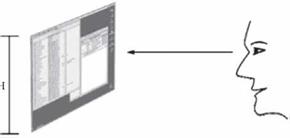Viewing distances are often determined by physical restrictions, such as ceiling height or the height of the consoles in the control room. Ideally the display size should be selected according to the amount of information required and the required or available viewing distance (Figure 4.10).
The more information with a given viewing distance, the larger the image that is required. If the number of viewers is high, a larger image is required. A single letter or digit might be perceivable up to a distance, which is 300 to 400 times the height of the letter; for example, if the image content is only a single letter, the screen size in relation to the viewing distance could be very small (Figure 4.11).
Studies have shown that the minimum required character size must be greater than a 16-arc minute, that is, 16/60°. This implies that the maximum viewing distance is 215 times the height of the character. What the eye is capable of perceiving is also called acuity. Therefore, a text displayed on a standard 17-inch PC cathode ray tube (CRT) monitor running at XGA resolutions (1024×768 pixels), the height of the individual letters will be approximately 2.7 mm. This will imply a maximum viewing distance of approximately 1200 mm (1.2 m). As the image height of the PC monitor is 240 mm, the ratio between viewing distance and image height is 5:1 (Figure 4.12).
Selecting the right display size should be considered on a case-by-case basis. DIN has a standard (No. 19045-1) that includes some guidelines for typical applications in meeting rooms, which can also be applied for control rooms.
 |
 5 x H
5 x H
FIGURE 4.12 Ratio of image height and viewing distance.
DIN 19045-1:
Minimum viewing distance: 1.5 x width of the display Maximum viewing distance: 6 x width of the display
A viewing distance of 4 times the height of the image is recommended as providing the optimum information from an image. The viewing distance should not be less than twice the image height, and the maximum viewing distance not be beyond 8 times the image height. It should be remembered that the DIN standard was developed before PC-based applications became state-of-the-art. Where the application includes standard PC presentations from a Windows-based PC running XGA (1024 x 768) resolutions, the longest viewing distance should not exceed 6 times the image height. If the resolution is increased to SXGA (1280 x 1024), viewing distance should not exceed 4.5 times the image height. High-resolution computer graphics requires the closest viewing distance, whereas video images can be perceived at a longer distance (depending on their size).



